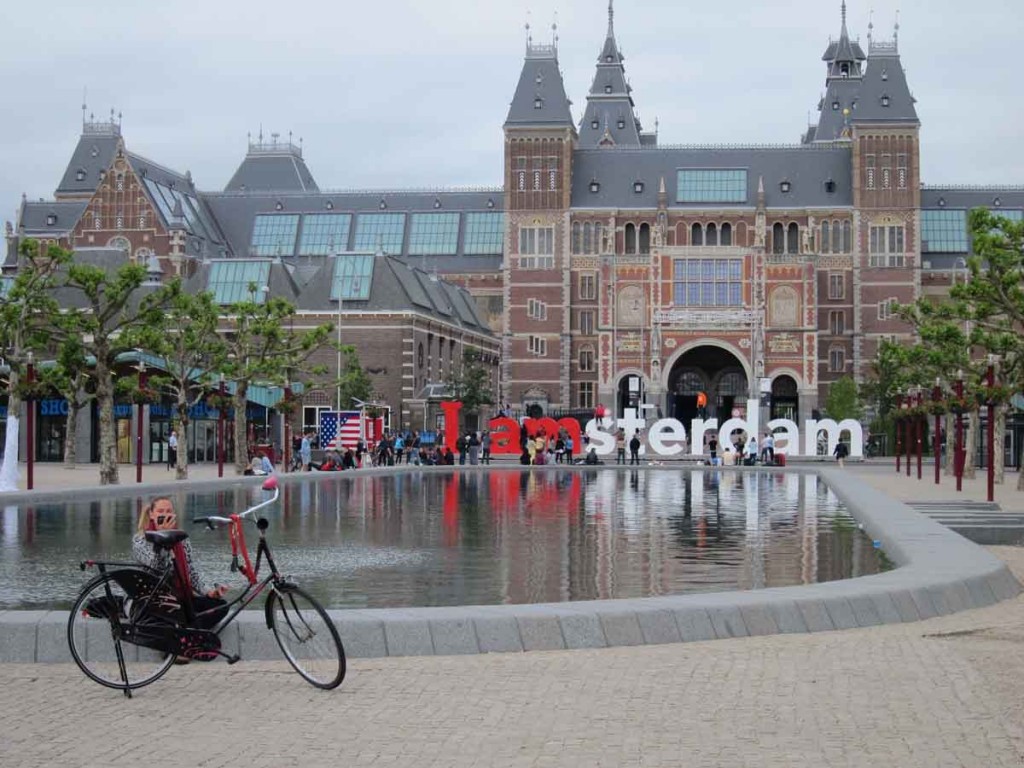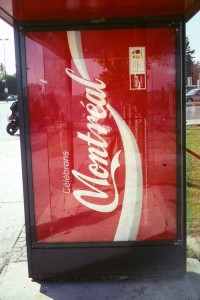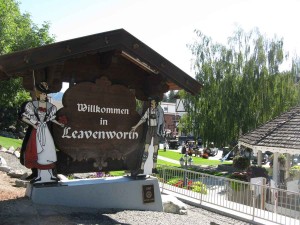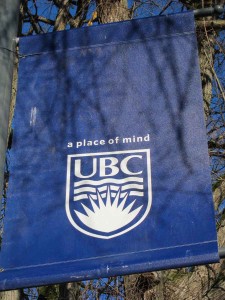
One of the quintessential place branding campaigns. The epicentre of I amsterdam at the Rijksmuseum in Amsterdam.
Place branding does to places what advertising does for products – it aims to sell them. Place branding is said to attract tourists, investment and industries looking for a new home. And it promotes places even to their own inhabitants by creating stronger and more coherent place identities.
 The promotion of places has a deep history. Stephen Ward’s 1998 book Selling Places examines, for example, how land in California and Oregon was advertised to attract people to make the hard overland journey across America, and the ways health resorts and spas such as Blackpool and Saratoga Springs attracted visitors a century or more ago, and how suburbs in Britain and America were sold in the 1930s. This romantic illustration of Tunbridge Wells is from London Transport’s Metroland campaign of the 1930s (it was in a 2015 calendar on my office wall). Nevertheless, since 1990 such promotion has become formally named place branding and a widely adopted marketing approach to place. Most cities, and tourist destinations, and many universities and even nations are now branded.
The promotion of places has a deep history. Stephen Ward’s 1998 book Selling Places examines, for example, how land in California and Oregon was advertised to attract people to make the hard overland journey across America, and the ways health resorts and spas such as Blackpool and Saratoga Springs attracted visitors a century or more ago, and how suburbs in Britain and America were sold in the 1930s. This romantic illustration of Tunbridge Wells is from London Transport’s Metroland campaign of the 1930s (it was in a 2015 calendar on my office wall). Nevertheless, since 1990 such promotion has become formally named place branding and a widely adopted marketing approach to place. Most cities, and tourist destinations, and many universities and even nations are now branded.
This recent surge of interest seems to be a manifestation of the neo-liberal reality that places now have to compete with one another for a slice of the economic pie. Torril Nyseth and Arvid Vikken claim that in the context of globalization and fluid capital it has become important for everywhere to appear attractive and to have a strong place brand. “Routes,” they write (p.3) in a particularly striking turn of phrase, “become more important than roots…Every place is a global space.”
The Supposedly Complex Processes of Place Branding
The aim of place branding is to differentiate somewhere from its competitors by creating and managing distinctive images of it. These images might be visual or consist of a catch-phrase or logo, but they should, as just about every book or website on place branding stresses, reinforce actual assets. In other words it’s not enough just to come up with a good logo or to invent a compelling story. Simon Anholt expresses this neatly in his book on brand management: “Good advertising,” he writes (p19), “can only make a bad product fail faster: and the same is most certainly true of places.” Nevertheless, many places have adopted generic, placeless brands.


Brampton, a city in southern Ontario, was for a long time a major centre for commercial flower cultivation. Its brand connects to its history. The brand tag for Surrey in British Columbia is generic – the future presumably lives everywhere.
Place branders are well aware of this tendency to be generic because they claim their task is more difficult than advertising products. For instance, the UK consulting firm Saffron argues in a post on how to create a place brand that: “Places are complex things – even the smallest of them are much more complicated than a can of soup or a mobile phone. People live there, visit there, play there, work there, study there and even die there.” Similarly Anholt suggests (p 4) that ”nobody doubts that places have their brand images, and that those images are critical to the success in the many international competitions that characterize the modern economy….But the tiniest village is infinitely more complex, more diverse and less unified than the largest corporation.”

This image (I have also used it in another post) captures the link between branding and commodification of place. The ad/sign was for the 350th year of Montreal’s founding..
In spite of this assumed complexity what branding actually does is to package a place as a sort of commodity. The intention and hope is that the brand will encapsulate actual place assets and reinforce place identity in ways that turn it from being somewhere in the doldrums into somewhere where people want to live, work, visit and invest. Even though this may not always work, it has clearly become a standard requirement for cities and institutions alike. If somewhere doesn’t have a brand, it’s almost as though it has given up, not even bothering to compete.
Aspects of Place Branding
In practice branding involves tag-lines, slogans, and themed packages of fonts, colours and images, all which can be variously used in brochures and websites, on posters, on letterhead and lamppost banners, in promotional campaigns and economic development strategies. The more compressed and flexible the brand is, the better, because that allows them to be used either in a wide range of circumstances or to serve as metaphor for the place itself. I ❤ NY is the quintessential example. People writing about place branding also like Iamsterdam and What happens in Vegas stays in Vegas. However, I think it is fair to say that most are not this catchy and many are downright obscure. For instance, I have no idea what to make of the tag “Absolutely. Positively” that has been adopted by Wellington in New Zealand, or Sunderland’s “See it, Do it”, shown below.
 If somewhere doesn’t have many assets that can be used as the basis for branding, what does exist can be physically amplified or even created, more or less on the build it and they will come principle. This is sometimes done by small towns, such as pseudo-Bavarian Leavenworth in Washington, which adopt attractive foreign identities and thus turn themselves into tourist attractions. At a larger scale it is clear that the Eiffel Tower, the CN Tower in Toronto, and the Sydney Opera House all serve as instant identity markers for those cities, even though they were built for other purposes. A more intentional approach to place branding aims to achieve the same effect by building spectacular destination architecture – a process that has been called the Bilbao Effect after Frank Gehry’s curvy, bulbous Guggenheim Museum that brought the the city to global prominence and boosted the regional economy. There are many other strategies that aim to enhance place brands by building or amplifying assets – waterfront restoration, cultural festivals, the designation of world heritage sites, gay pride parades, Olympic Games can all attract lots of publicity and draw in people and money.
If somewhere doesn’t have many assets that can be used as the basis for branding, what does exist can be physically amplified or even created, more or less on the build it and they will come principle. This is sometimes done by small towns, such as pseudo-Bavarian Leavenworth in Washington, which adopt attractive foreign identities and thus turn themselves into tourist attractions. At a larger scale it is clear that the Eiffel Tower, the CN Tower in Toronto, and the Sydney Opera House all serve as instant identity markers for those cities, even though they were built for other purposes. A more intentional approach to place branding aims to achieve the same effect by building spectacular destination architecture – a process that has been called the Bilbao Effect after Frank Gehry’s curvy, bulbous Guggenheim Museum that brought the the city to global prominence and boosted the regional economy. There are many other strategies that aim to enhance place brands by building or amplifying assets – waterfront restoration, cultural festivals, the designation of world heritage sites, gay pride parades, Olympic Games can all attract lots of publicity and draw in people and money.
The Place Brand Observer
Numerous consultants offer services to assist places identify their brands, for example, Place Matters, and Place Brand. Resonance Consulting “creates development strategies, plans and brands that shape the future of places around the world,” and claims to have cities and communities in more than 70 countries to help them realize their full potential.


Sunderland, in North-East England is known as the City of Light because it was here that Joseph Swan invented the incandescent electric light bulb independently and at the same time as Edison. It is where George Washington’s family came from and claims to be the only city in the world twinned with Washington DC, which has a trademarked brand in the colours of the American flag.
Place branding has become an academic discipline with university degree programmes dedicated to it (e.g. the Institute of Place Management at Manchester University in the UK, Programme in Place Branding at Stockholm University, and others in Aix-en-Provence and Los Angeles). There is at least one academic journal explicitly dedicated to it (Place Branding and Public Diplomacy) and several that are closely related (Journal of Place Management and Development, The Journal of Destination Marketing and Management).
This flurry of both business and academic interest in place branding is conveniently synthesised at The Place Brand Observer, a “niche portal and think-blog” website. This has entries targetting professionals that include, for example, interviews with experts and tutorials on how to brand places. It also has entries for academics that include discussions of place-branding theory, links to relevant journals, and lists of academic programmes. In December 2015 it also included a discussion of place branding and sustainability in which it is argued that sustainability offers a competitive advantage because environmental and social best practices are essential for providing rewarding tourism experiences and creative business environments.
Mississauga
The Place Brand Observer also reports on actual cases, and one of those reports is about Mississauga in southern Ontario, somewhere I know well. It is the sixth largest city in Canada, but it is also part of the conurbation of over six million people that is centred on Toronto. Even though it has a high rise downtown, some internationally famous building and a culturally diverse and enthusiastic population it has an identity problem. So Mississauga appointed a brand manager who has developed a Brand Book that led to the creation of a new logo that is intended to consolidate the cultural diversity, settlement history and economic vitality of the city.

I have no idea how successful this logo and brand will be, whether to take the semiotic analysis of it seriously, or how to judge its success. The Brand Book indicates the logo was developed through an elaborate consultation process, but to me it looks almost exactly like the back of an envelope. I prefer the Mi-Way brand used on the side of Mississauga’s buses, no doubt dreamt up by some Sinatra fan.

Place branding, reinvention, sustainability and hyperreality
The proponents of place branding stress that it is more than providing a quick fix to try to boost a local economy. They regard it as an aspect of a long-term, sustainable strategic process of that will lead to genuine change. Nyseth and Vikken describe this as a process of “place reinvention” that involves ongoing planning as well as branding, and emphasise that both have to be allowed to develop together as “something that just happens with more or less unintended consequences.” In other words place branding is something that can set a process in motion leading both to economic development and to enhanced commitments by residents to the place where they live and work.
Regardless of whether this is actually the case and regardless of whether place branding has any tangible effects, there is no doubt that the identities of places at all scales – stores such as the Body Shop, universities and their campuses, towns, World Heritage sites, cities, regions and even nations, now find it necessary to create brand identities that blend reality (their assets) with some degree of invention (their brands). Staci Zavattaro in her 2014 book Place Branding through Phases of the Image: Balancing Image and Substance, argues that the way cities use promotional strategies inevitably blends fiction and reality. And she borrows from arguments of the social philosopher Jean Baudrillard to suggest that place branding involves a shift from reality towards simulacra in a society drifting towards hyperreality.
I am more inclined to regard place branding in less theoretical terms as a particular form of advertising. Like all advertising it can sometimes be amusing, sometimes persuasive, and sometimes deceitful. It is an almost omnipresent component of the identities of places in this century, and sometimes it reinforces those identities and sometimes it detracts from them.

Branding of the University of British Columbia
Books Referenced
• Simon Anholt 2010 Places: identity, image and reputation (New York : Palgrave Macmillan).
• Torill Nyseth and Arvid Viken 2009 Place Reinvention : northern perspectives (Farnham: Ashgate)
• Stephen Ward 1998 Selling places; the marketing and promotion of towns and cities 1850-2000 (New York E & FN Spon)
• Staci Zavarotto 2014 Place Branding through Phases of the Image: Balancing Image and Substance (New York; Palgrave Macmillan)